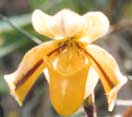 The Kerala Government has written to the Central Government urging
it to include kurinji (Strobilanthes kunthiana) in the Sixth Schedule
of the Wildlife (Protection) Act, 1972. This is hardly needed. What is
required is the protection of plant’s habitat.
The Kerala Government has written to the Central Government urging
it to include kurinji (Strobilanthes kunthiana) in the Sixth Schedule
of the Wildlife (Protection) Act, 1972. This is hardly needed. What is
required is the protection of plant’s habitat.Kurinji is a plant that grows like a weed at high altitudes on the Western Ghats, provided that there is open space. It is endemic to the Ghats, but no way rare or endangered at the moment. Though it is said to have medicinal properties, there is no trade or exports that would lead to its extinction. (Medicinal properties are actually associated with a black stalked variety of kurinji). The real threat to kurinji and several other endemic species on the Western Ghats is the destruction of their habitat and it is the habitat that needs to be protected.
 Ladies Slipper Orchid
Ladies Slipper Orchid The only plant from Kerala that has been included in the Schedule is the Paphiopedilum druryi, which comes under the general category of ladies slipper orchids included in the Schedule. This is a plant that is found only in a limited habitat at Agastyarkoodam and its environs. The plant was rediscovered after decades early in the nineties. It is definitely a plant requiring specific and special protection.
That, however, is not the case with kurinji. It grows on large areas spread from Nilgiris to Palanis and Munnar. (There are some reports that it also occurs at the northern end of the Western Ghats). It even occurs on roadsides. If its habitat is in Kerala and Tamil Nadu are protected as wildlife sanctuary, general protective provisions of the Wildlife Act would apply to kurinji and other species in the sanctuary. This would suffice for its protection (in fact, there are other species needing much more protection in the shola grasslands) and there would be no need to invoke stringent provisions of the Act that apply to Scheduled animals and plants.

Such stringent provisions will impair use of kurinji for medicinal, religious or other purposes and raising of the plant in a nursery (except under licence). You cannot possess or transport the plant, not to speak of any sale in the species.
Kurinji and culture
In some temples in Tamil Nadu, kurinji flowers are offered to Lord Murukan. There is little justification of breaking the cultural ties of the people with kurinji. The plant also occurs in some cultivated areas. Its inclusion in the Schedule could lead to even the farmers being booked for violation. Some forest officials may use it an excuse for collecting bribes.
The Government decision to recommend inclusion of the plant in the Schedule may be prompted by fears that visitors to Munnar and other places during the current season would pluck the flowers and uproot plants in large numbers. The inclusion of the plant in the Schedule, however, may not materialise before the season is over. Besides, general provisions of the Wildlife Act and other forest laws are enough to check wanton destruction of the plants. The Government has already taken an informal decision to impose a fine of Rs. 1000 on visitors destroying the plant or its blossoms.
Over-kill
We have a tendency to over-legislation. Our statute books are full of laws, many of them unnecessary. Proliferation of such laws lead to large-scale law breaking, and the people lose their inhibition to break law. So, excessive restrictions should always be avoided.
 People have emotional attachment towards gardens and flowers. Most do
not develop such attachments towards forests or individuals species
there. This is an occasion for the Forest Department to show the people
the beauty of kurinji, the wonder of its flowering, and imbibe love for
nature.
People have emotional attachment towards gardens and flowers. Most do
not develop such attachments towards forests or individuals species
there. This is an occasion for the Forest Department to show the people
the beauty of kurinji, the wonder of its flowering, and imbibe love for
nature. Mementoes
As the plant occurs widely in a geographical location, it need not be isolated from people. It would not be wrong to offer visitors a flower or two (in limited numbers and possibly at a price) as part of a memento. The tribals could be engaged to make something interesting and sell them. Of course, they can also offer kurinjithen (sweet honey from the kurinji habitat in season). Why not price it a little bit high?
There would be three types of visitors to the kurinji hills this season. Some would be satisfied with just a glimpse of the flowers. Others may want to trek. They may include nature lovers and people bent on vandalism. The Forest Department has to be vigilant against the latter. It is to be remembered that the main threat to kurinji is not people but the spreading plantations including that of the Forest Department.
